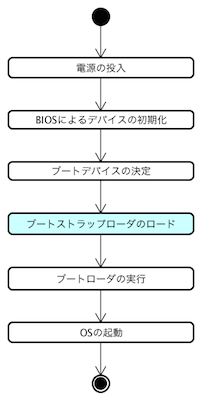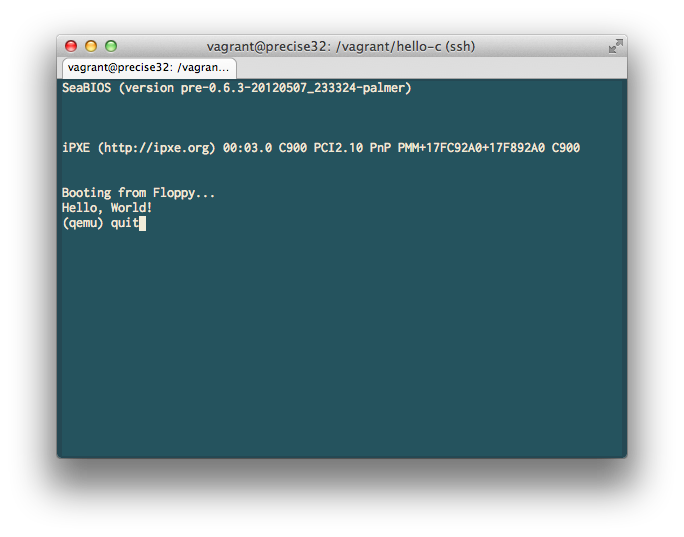はじめに
前回の「アセンブリ言語でHello, World!」をC言語に置き換えました。サンプルプログラムはこちらです。
開発環境は前回と同じ環境です。
ブートストラップローダ領域
PCの電源を投入するとBIOSと呼ばれるソフトウェアが起動します。このBIOSはデバイスの初期化などが終わると、ブートデバイス(FDDやHDDなど)のMBR(Master Boot Record)をメモリ上にロードし、MBR領域にあるプログラムに制御を移します。このMBR領域にあるプログラムをブートストラップローダと呼びます。
プログラムの作成
code16gcc.h はGCCにプログラムが16BITモードであることを伝えます。
#ifndef _CODE16GCC_H_
#define _CODE16GCC_H_
__asm__(".code16gcc\n");
#endif
インラインアセンブラを使用して、前回と同じように「Hello, World!」を出力するプログラムを作成します。
#include"code16gcc.h"
__asm__("jmp main");
#define TEXT_COLOR_WHITE 0x07
void print(const char *s)
{
while(*s) {
// BIOSの機能を呼び出して、画面に一文字出力する
__asm__ __volatile__ ("int 0x10" : : "a"(0x0E00 | *s), "b"(TEXT_COLOR_WHITE));
s++;
}
}
void main(void) {
print("Hello, World!");
while(1) {
// CPUの動作を停止する
__asm__ __volatile__("hlt");
}
}
BIOSはメモリ上の0x7C00番地にMBRをロードします。よってプログラムの開始位置は0x7C00番地となります。ブートシグニチャ(0xAA55)はMBRが有効であるという署名のようなもので、ブートシグニチャがないとMBRが無効なものとして扱われます。ブートシグニチャはMBRの510〜511バイトにあります。ブートシグニチャのメモリ上のアドレスは0x7DFE番地(0x7C00 + 510バイト = 0x7DFE)です。
ENTRY(main);
SECTIONS
{
/* プログラムの開始位置 */
. = 0x7C00;
.data : { hello.o; }
/* ブートシグニチャ */
. = 0x7DFE;
.sig : { SHORT(0xaa55); }
}
バイナリファイルの作成
標準ライブラリのリンク情報(デバック情報など)を取り除いた、オブジェクトファイル(hello.o)を作成します。
# コンパイル
gcc -m32 -ffreestanding -fno-common -fno-builtin -fomit-frame-pointer -O2 -c -o hello.o hello.c
リンカーを使用してオブジェクトファイル(hello.o)からバイナリファイル(hello.bin)を作成します。
# バイナリファイルの作成
ld -m elf_i386 -s -static -Tlinker.ld -nostdlib -nmagic --oformat binary -o hello.bin hello.o
前回と同じようにフロッピーディスクイメージにバイナリファイルを書き込みます。QEMUを実行して「Hello, World!」と出力されたら成功です。
サンプルプログラムの実行
# Vagrantの起動と接続
host$ vagrant up
host$ vagrant ssh
# サンプルプログラムの実行
vagrant$ cd /vagrant/hello-c
vagrant$ rake
OBJECT_FILE = 'hello.o'
BINARY_FILE = 'hello.bin'
IMAGE_FILE = 'floppy.img'
LINKER_FILE = 'linker.ld'
task :default => :run
task :run => [ BINARY_FILE, IMAGE_FILE ] do
sh "dd status=noxfer conv=notrunc if=#{BINARY_FILE} of=#{IMAGE_FILE}"
sh "qemu -boot a -fda #{IMAGE_FILE} -curses -monitor stdio"
end
file BINARY_FILE => [ LINKER_FILE, OBJECT_FILE ] do
sh "ld -m elf_i386 -s -static -T#{LINKER_FILE} -nostdlib -nmagic --oformat binary -o #{BINARY_FILE} #{OBJECT_FILE}"
end
file IMAGE_FILE do
sh "qemu-img create -f raw #{IMAGE_FILE} 1440K"
end
rule '.o' => '.c' do |t|
sh "gcc -masm=intel -m32 -ffreestanding -fno-common -fno-builtin -fomit-frame-pointer -O2 -c -o #{t.name} #{t.source}"
end
rule '.s' => '.c' do |t|
sh "gcc -S -masm=intel -m32 -ffreestanding -fno-common -fno-builtin -fomit-frame-pointer -O2 -c -o #{t.name} #{t.source}"
end
require 'rake/clean'
CLEAN.include([ '*.bin', '*.img', '*.o' ])
おまけ
C言語をアセンブリ言語に変換して、前回のプログラムと比較してみましょう。
次のコマンドを実行すると hello.c から hello.s が作成されます。
cd /vagrant/hello-c-optimization
rake hello.s
次のプログラムは読み易くするために、不要なディレクティブ(.xxxx)を取り除いています。
NASMとGCCの出力するアセンブリ言語では若干構文が異なります。
.file "hello.c"
.intel_syntax noprefix
.code16gcc
jmp main
print:
push ebx
mov edx, eax // EDX レジスタに文字列の先頭アドレスを設定する
movzx eax, BYTE PTR [eax] // 文字列から一文字を取得し EAX レジスタに設定する
test al, al
je .L1
mov ebx, 7 // 文字色(白)(0x07)
.L4:
movsx eax, al
or ah, 14 // BIOSに一文字表示を伝える(0x0E)
int 0x10 // BIOSの機能を呼び出す。Call video interrupt.
add edx, 1 // EDX レジスタをインクリメントする
movzx eax, BYTE PTR [edx] // 文字列から一文字を取得し EAX レジスタに設定する
test al, al
jne .L4
.L1:
pop ebx
ret
.LC0:
.string "Hello, World!"
main:
mov eax, OFFSET FLAT:.LC0 // EAX レジスタに文字列の先頭アドレスを設定する
call print
.L8:
hlt
jmp .L8

